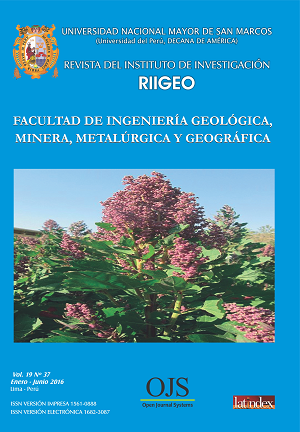Adaptation of quinoa (Chenopodium quinoa willd) cultivation to climate change in the Peruvian Andes
DOI:
https://doi.org/10.15381/iigeo.v19i37.12950Keywords:
climate change, varieties, phenological phases, economic analysisAbstract
This research work deals with the adaptation of the cultivation of quinoa (Chenopodium quinoa willd) to climate change in the Andes of Peru. The research study was carried out in the Áncash region (Ocros) and in the Huancavelica region (Angaraes), between September 2011 and September 2014, under field conditions. The land was installed and conducted under the statistical model of complete random blocks, with 25 repetitions and five varieties of quinoa. Yield, plant height, panicle height, diseases such as mildew, harvest index (CI) and phenological phases (in days and heat units to reach each vegetative development phase) were evaluated. Of the five varieties, three showed better agronomic behavior and reached the highest yields. The treatments of the quinoa varieties were randomly distributed in each plot within each block and the densities were randomly assigned in the subplots within each plot. Finally, the economic analysis indicates that the INIA Salcedo and Blanca Junín varieties showed the highest production yield in the years of study, showing a better behavior in adapting to climate change in the Andes of Peru.
Downloads
Published
Issue
Section
License
Copyright (c) 2016 Edgar Amador Espinoza Montesinos

This work is licensed under a Creative Commons Attribution-NonCommercial-ShareAlike 4.0 International License.
AUTHORS RETAIN THEIR RIGHTS:
a. Authors retain their trade mark rights and patent, and also on any process or procedure described in the article.
b. Authors retain their right to share, copy, distribute, perform and publicly communicate their article (eg, to place their article in an institutional repository or publish it in a book), with an acknowledgment of its initial publication in the Rev. Inst. investig. Fac. minas metal cienc. geogr.
c. Authors retain theirs right to make a subsequent publication of their work, to use the article or any part thereof (eg a compilation of his papers, lecture notes, thesis, or a book), always indicating the source of publication (the originator of the work, journal, volume, number and date).























